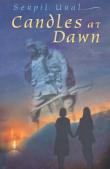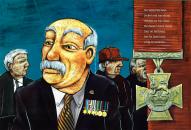AustLit
The material on this page is available to AustLit subscribers. If you are a subscriber or are from a subscribing organisation, please log in to gain full access. To explore options for subscribing to this unique teaching, research, and publishing resource for Australian culture and storytelling, please contact us or find out more.
Latest Issues
AbstractHistoryArchive Description
Told from a Turkish perspective, this novel relates the story of two teenage girls, one from Australia and one from Turkey, who meet and become friends. They discover that their grandfathers had fought on opposite sides at Gallipoli.
Notes
-
Translated from the original 1997 Turkish publication.
While in manuscript form, this novel won a Turkish literary award.
Affiliation Notes
-
This work is affiliated with the AustLit subset Asian-Australian Children's Literature and Publishing because it is set in the Middle East.
Publication Details of Only Known VersionEarliest 2 Known Versions of
Works about this Work
-
Ruins or Foundations : Great War Literature in the Australian Curriculum
2012
single work
criticism
— Appears in: JASAL , vol. 12 no. 1 2012; 'The Great War has been represented in Australian curricula since 1914, in texts with tones ranging from bellicose patriotism to idealistic pacifism. Australian curricula have included war literature as one way of transmitting cultural values, values that continue to evolve as successive generations relate differently to war and peace. Changes in ethical perspectives and popular feeling have guided text selection and pedagogy, so that texts which were once accepted as foundational to Australian society seem, at later times, to document civilisation's ruin.
In recent years, overseas texts have been preferred above Australian examples as mediators of the Great War, an event still held by many to be of essential importance to Australia. This paper first considers arguments for including Great War texts on the national curriculum, exploring what war literature can, and cannot, be expected to bring to the program. Interrogating the purpose/s of war literature in the curriculum and the ways in which the texts may be used to meet such expectations, the paper then discusses styles of war texts and investigates whether there is a case for including more texts by Australian authors.' (Author's abstract)
-
An Awfully Big Adventure : Killing Death in War Stories for Children
2006
single work
criticism
— Appears in: Papers : Explorations into Children's Literature , December vol. 16 no. 2 2006; (p. 90-95) Halliday locates a gap in Kerry Mallan's study concerning discourses of death and dying in children's literature, and claims, 'A curious omission is death in war, from the legal killing of and by soldiers, to the horror underlying the euphemism of 'collateral damage'' (90). Halliday suggests that despite a 'proliferation of discourses [on the] manifestations of death... there is a lingering taboo in dealing with death in war stories, especially for older readers' (90). The essay refers to some of the strategies and narrative techniques used to represent war in children's fiction from an array of novels, including several Australian children's texts by contemporary authors, Morris Gleitzman, Sonya Hartnett, Anthony Eaton, Serpil Ural and David Metzenthen. Strategies discussed include discourses of hope, the use of metaphor, reader-subject positioning and setting with Halliday concluding that, 'When death is present and brutally explicit...cultural pressures about the appropriateness of reading material and consequent censorship occur' (94). -
Untitled
2004
single work
review
— Appears in: Reading Time : The Journal of the Children's Book Council of Australia , May vol. 48 no. 2 2004; (p. 26)
— Review of Candles at Dawn 1997 single work novel -
Young Readers
2004
single work
review
— Appears in: The Weekend Australian , 12-13 June 2004; (p. 15)
— Review of Dark Dreams : Australian Refugee Stories 2004 anthology autobiography biography essay poetry ; Candles at Dawn 1997 single work novel -
Faces of War Expose Our Moral Dilemma
2004
single work
review
— Appears in: The Sydney Morning Herald , 24-25 April 2004; (p. 10-11)
— Review of Candles at Dawn 1997 single work novel
-
Faces of War Expose Our Moral Dilemma
2004
single work
review
— Appears in: The Sydney Morning Herald , 24-25 April 2004; (p. 10-11)
— Review of Candles at Dawn 1997 single work novel -
Young Readers
2004
single work
review
— Appears in: The Weekend Australian , 12-13 June 2004; (p. 15)
— Review of Dark Dreams : Australian Refugee Stories 2004 anthology autobiography biography essay poetry ; Candles at Dawn 1997 single work novel -
Untitled
2004
single work
review
— Appears in: Reading Time : The Journal of the Children's Book Council of Australia , May vol. 48 no. 2 2004; (p. 26)
— Review of Candles at Dawn 1997 single work novel -
Gallipoli Book Spreads Message of Peace
2003
single work
column
— Appears in: The Canberra Times , 9 April 2003; (p. 6) -
An Awfully Big Adventure : Killing Death in War Stories for Children
2006
single work
criticism
— Appears in: Papers : Explorations into Children's Literature , December vol. 16 no. 2 2006; (p. 90-95) Halliday locates a gap in Kerry Mallan's study concerning discourses of death and dying in children's literature, and claims, 'A curious omission is death in war, from the legal killing of and by soldiers, to the horror underlying the euphemism of 'collateral damage'' (90). Halliday suggests that despite a 'proliferation of discourses [on the] manifestations of death... there is a lingering taboo in dealing with death in war stories, especially for older readers' (90). The essay refers to some of the strategies and narrative techniques used to represent war in children's fiction from an array of novels, including several Australian children's texts by contemporary authors, Morris Gleitzman, Sonya Hartnett, Anthony Eaton, Serpil Ural and David Metzenthen. Strategies discussed include discourses of hope, the use of metaphor, reader-subject positioning and setting with Halliday concluding that, 'When death is present and brutally explicit...cultural pressures about the appropriateness of reading material and consequent censorship occur' (94). -
No-Man's-Land Has Two Sides : A View for Children of Gallipoli, 1915, from the Turkish and Australian Trenches
2003
single work
criticism
— Appears in: Bookbird , vol. 41 no. 4 2003; (p. 21-27) Examines books dealing with the same campaign, reflecting the feelings of people whose ancestors fought that battle nearly ninety years ago -
Ruins or Foundations : Great War Literature in the Australian Curriculum
2012
single work
criticism
— Appears in: JASAL , vol. 12 no. 1 2012; 'The Great War has been represented in Australian curricula since 1914, in texts with tones ranging from bellicose patriotism to idealistic pacifism. Australian curricula have included war literature as one way of transmitting cultural values, values that continue to evolve as successive generations relate differently to war and peace. Changes in ethical perspectives and popular feeling have guided text selection and pedagogy, so that texts which were once accepted as foundational to Australian society seem, at later times, to document civilisation's ruin.
In recent years, overseas texts have been preferred above Australian examples as mediators of the Great War, an event still held by many to be of essential importance to Australia. This paper first considers arguments for including Great War texts on the national curriculum, exploring what war literature can, and cannot, be expected to bring to the program. Interrogating the purpose/s of war literature in the curriculum and the ways in which the texts may be used to meet such expectations, the paper then discusses styles of war texts and investigates whether there is a case for including more texts by Australian authors.' (Author's abstract)
Last amended 2 Jul 2014 14:05:32
Subjects:
-
Gallipoli,
cTurkey,cMiddle East, Asia,
Settings:
-
Gallipoli,
cTurkey,cMiddle East, Asia,
Export this record





